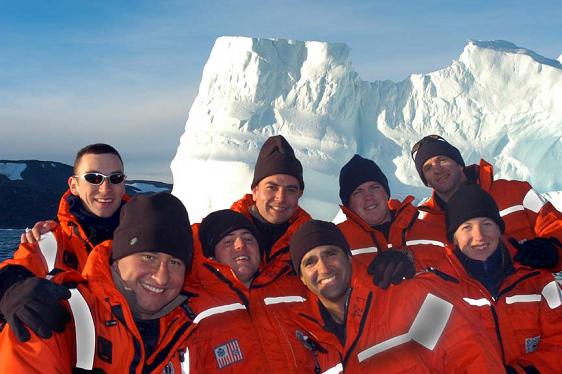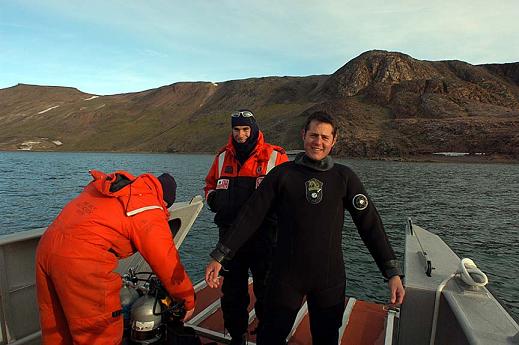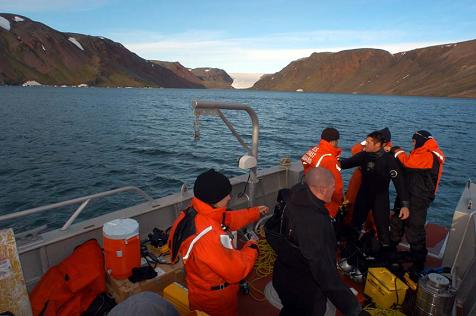|
|
Expedition
Expedition | People
|
Log - August-3-2003
by Robert McCarthy
Previous | Next
Heroes "Down-Under"!
Robert McCarthy |
 |
Heroes! Everybody needs heroes. People you admire for their courage, will, desire, character, athletic ability, artistic creativity, musical performance, etc. that you strive to mimic. Well, yesterday I was honored to witness 6 heroes! The six individuals are: LTJG Neil Amaral (front row third from left), MST3 Suzanne Scriven (front row to Neil’s left), BM1 Dave Grob (back row behind Suzanne), BM2 Darrel Bresnahan (back row first from left), BM3 Scott Lussier (front row on Neil’s right), and DC2 Todd Gillick (back row on Dave’s right). (See picture 1. Also pictured are MK2 Rich Titus, front row first on left, and BM1 Pat Morkis, back row next to Darrell. Pictures today are courtesy of Dave Forcucci.) These 6 heroes are the “diving team”! Yesterday, when they left the ship at noon, nobody thought that they wouldn’t return until after midnight. And what makes these divers heroes is not just the physical endurance and mental fatigue that they endured, but their attitude while out there in that tiny boat and when they returned to the ship. They weren’t whining to come back to the ship, complaining about how cold they must have been, or how hungry they must have been. They wanted to perform for the science crew, and that meant diving for clams. And even though the thought of diving in these waters might seem glamorous at first, jumping in and going down in these waters took guts. |
| After surveying the area with an underwater camera, they decided to start the dive expedition nearest the coast. The first two divers in the water were Suzanne and Scott. This first dive was the shallowest, and Neil told me they were down about 16 feet deep. At that depth, their visibility was about 15 feet. They dove into kelp beds, and persevered for 34 minutes looking for clams. The next divers in were Dave and Darrell. They went deeper and stayed in about 44 minutes. This dive produced a clam, and everybody was excited, especially Robie and Mary. Then it was Neil’s turn, and he dove alone. However, he was “tended” with a rope and there was a diver suited up on standby if anything went wrong. The two scientists, Robie and Mary, then returned to the ship and all divers had the option to return with them. But they all wanted to go to the next dive site. Here they anchored a pressure sensor to the bottom. Scott went down again, accompanied with Todd. Here the depth was 73 feet, and after the sensor was secured to the bottom, they returned in 17 minutes. They saw clams at this site, but because of the location of site, it was determined not to be the best site for the clams to “tell their story”. |
 |
 |
These divers were ready to do it again today, but the ice cover was too thick to allow the small boat into the desired location to place another pressure sensor. These pressure sensors will help the physical oceanographers determine the major driving forces for the flow through Nares Straight. As Dr. Andreas Muenchow said earlier on this cruise, “it’s all about F=ma”. With the velocity measurements, physical oceanographers can determine the acceleration, and by knowing that, they can figure out what is causing the water to move inside the straight. Ideally they are hoping for at least 4 bottom mounted pressure sensors along the straight, (at least 2 on each side). |
| And while I’m honoring these divers, it’s time again to thank the entire crew for their service, and the science crew for their patience. Everyone is working long hours and getting irregular night-sleeps, and they still are more than happy to answer Gerhard’s and my questions. It’s a friendly science crew, because I sense that everyone feels blessed to be apart of this team and witness majestic sights we see daily. Thanks again to Drs. Falkner and Muenchow for allowing Gerhard and myself to experience this oceanographic cruise. |
|
